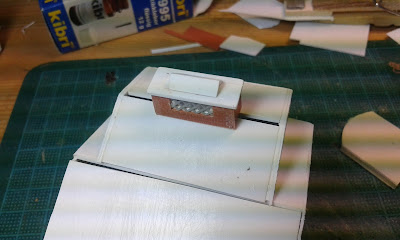Since nobody could tell me exactly which color the windows and doors were painted in, I used a bit of modelers license and painted them turquoise. This is a color which I often saw on stucco structures and also used on several Santa Fe depots in the Southwest.
Test fitting the depot on the layout.
The finished outhouse.
From the photos, I copied the depot lettering and tried to reproduce it as best as I could. I used the carbon copying method, by blackening the back of the paper with my pencil and pasting it directly on the wall.
It worked out quite well.
With a black marker pen I followed the pencil lines. I'm not totally happy with the outcome, because the lettering turned out to be too bold. I will probably redo it with a finer marker.
I glued a sheet of scale lumber to the baseboard to represent the concrete base and platform for the depot. After the glue had dried I painted it a concrete color.
Then I started with the scenicking of the depot scene. As ground cover I used real beach sand which I collected at the beach in Belgium near our annual vacation resort. I sifted the sand to remove small pebbles and clamshell debris and fixed it with a mix of white glue and distilled water. I wetted the entire area with a spray bottle of wet water (Isopropyl Alcohol added to the distilled water)
Woodland Scenics ground foam and static grass was applied while the ground was still wet.
There are still some details missing, but palm trees are so characteristic for Southern California, so that I had to plant these first.
Half of the depot area is finsihed. The rest to the far end of the room will follow after I modeled the bluffs to the left side against the backdrop and the large rocks protecting the tracks from being washed away by the waves. Unfortunately there will only be a very small strip of beach left.
As always, stay tuned for updates.













































